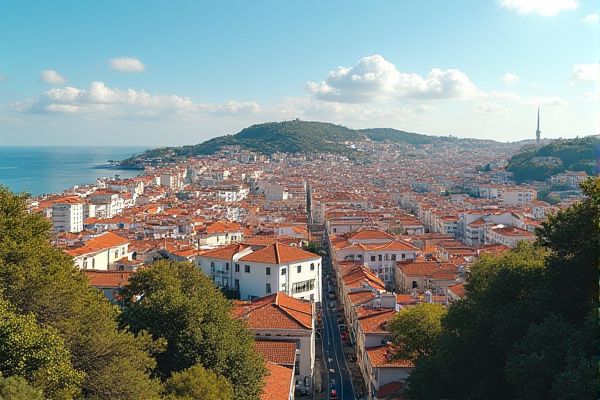
Weather and climate in Portugal: Mediterranean climate predominates. Hot, dry summers. Mild, wet winters. Influences from Atlantic Ocean. Regional climate variations exist. Sunniest months: June-August. Rainiest months: November-February. Coastal breezes moderate temperatures. Occasional Atlantic storms. Microclimates in mountainous areas.
Mediterranean climate predominates.
Portugal is predominantly characterized by a warm temperate, Mediterranean climate, with hot, dry summers and mild, potentially rainy winters, although the climate varies significantly across different regions. This climatic diversity is primarily influenced by the Atlantic Ocean and various geographical features. To gain a deeper understanding of the country's weather patterns throughout the year, you can explore the Comprehensive Guide to Every Season, which provides detailed insights into Portugal's weather intricacies.
Hot, dry summers.
In Portugal, hot and dry summers are characteristic of the southern regions, particularly in the Alentejo and the Algarve, where temperatures can exceed 100°F (38°C) and are mitigated by a constant sea breeze, especially in the Algarve. This beautiful coastal area benefits from the cooling effect of the ocean, providing some relief from the intense heat. The interior and southern parts of the country experience these extreme summer conditions, with the Alentejo region being notably hot and dry. For more detailed information about the climate in these regions, you can visit International Living’s website.
Mild, wet winters.
Portugal experiences mild and wet winters, characterized by average daytime temperatures of about 16°C (61°F), high rainfall, and only about 14 dry days on average. The Atlantic-facing coast is wetter than the Mediterranean-facing areas, showcasing distinct climatic differences. For more detailed climate information, visit the Weather Online report on Portugal's climate.
Influences from Atlantic Ocean.
The Atlantic Ocean significantly influences Portugal's climate, moderating summer temperatures and smoothing out winter's chill. This effect is particularly evident in the northern regions, where the ocean ensures summers remain temperate and winters are mild. In the southern areas, especially the Algarve, the ocean's influence results in hot, dry summers and mild winters. For a detailed understanding of how the ocean and other factors shape the country's weather patterns, you can explore this comprehensive guide to Portugal's weather.
Regional climate variations exist.
Portugal exhibits significant regional climate variations, with Northern Portugal characterized by a temperate maritime climate with cool, rainy winters and mild summers. Central Portugal enjoys a Mediterranean climate with hot, dry summers and cool, wet winters, while Southern Portugal, particularly the Alentejo and Algarve, experiences a hot-summer Mediterranean climate with hot, dry summers and mild, wet winters. The archipelagos of Madeira and the Azores have distinct subtropical and temperate maritime climates, respectively. For more detailed information about the country's diverse climatological patterns, you can visit the Weather Regions of Portugal on Our Portugal Journey.
Sunniest months: June-August.
The sunniest months in Portugal are June to August, characterized by minimal rainfall, with at least 10 hours of daily sunshine, rising to 12 hours in July, and daytime temperatures often reaching 25°C to 30°C (77°F to 86°F). For additional insights and updates on Portugal's weather, the Met Office offers comprehensive weather forecasts and travel information.
Rainiest months: November-February.
The rainiest months in Portugal are from November to February, with November marking the beginning of increased rainfall, especially in the northern regions. During these months, the winter months of December to February receive the majority of the annual rainfall. For detailed information, the Current Results website provides extensive data on precipitation patterns and weather trends in this region. Monitoring these trends is crucial for planning travel and agricultural activities effectively in Portugal.
Coastal breezes moderate temperatures.
Portugal's climate is significantly influenced by coastal breezes from the Atlantic Ocean, which moderate temperatures, especially in the northern and southern coastal regions, keeping summers cooler and winters milder compared to inland areas. This moderation results in comfortable temperatures, with the Atlantic breeze tempering the heat in summer and smoothing out the chill in winter. For a more detailed exploration of these climatic patterns, you can visit this Comprehensive Guide to Every Season provided by Vigilios.
Occasional Atlantic storms.
Portugal can experience occasional Atlantic storms, particularly in the winter, which bring strong winds and high rainfall, especially in the northern parts of the country, while the southern regions remain relatively milder. For more detailed information on weather patterns and travel advice, visit the Met Office website.
Microclimates in mountainous areas.
In Portugal's mountainous areas, such as the Serra da Estrela, the climate is characterized by colder temperatures and snowfall in winter, with temperatures often dropping below freezing. Summers are pleasantly warm, making it a haven for hikers and nature enthusiasts, while the higher altitudes like Penhas Douradas and Manteigas experience significant temperature variations throughout the year. For more detailed information on the distinctive weather patterns and environmental conditions of these regions, visit this insightful blog about Microclimates in Portugal.
